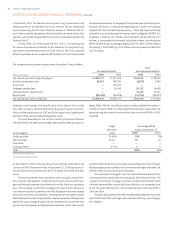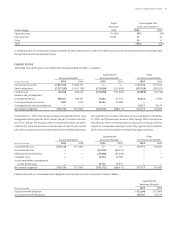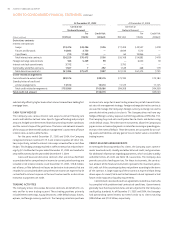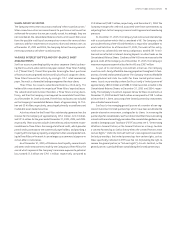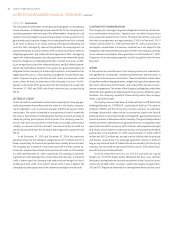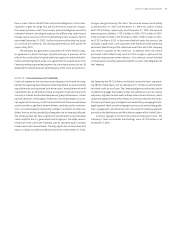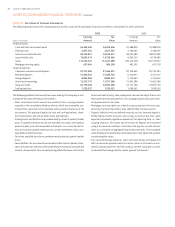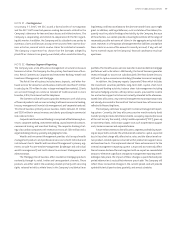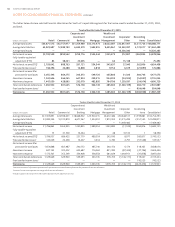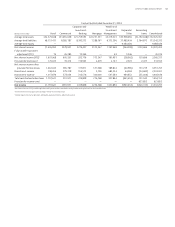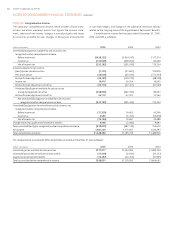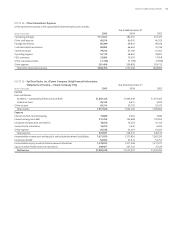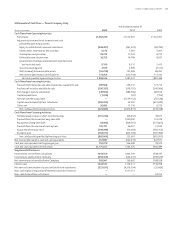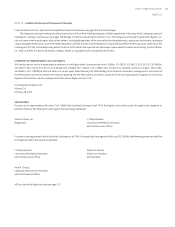SunTrust 2005 Annual Report Download - page 99
Download and view the complete annual report
Please find page 99 of the 2005 SunTrust annual report below. You can navigate through the pages in the report by either clicking on the pages listed below, or by using the keyword search tool below to find specific information within the annual report.SUNTRUST ANNUAL REPORT 97
NOTE • Concentrations of Credit Risk
Credit risk represents the maximum accounting loss that would be recog-
nized at the reporting date if borrowers failed to perform as contracted and
any collateral or security proved to be of no value. Concentrations of credit
risk (whether on- or off-balance sheet) arising from financial instruments
can exist in relation to individual borrowers or groups of borrowers, certain
types of collateral, certain types of industries, certain loan products, or cer-
tain regions of the country. Credit risk associated with these concentrations
could arise when a significant amount of loans, related by similar character-
istics, are simultaneously impacted by changes in economic or other con-
ditions that cause their probability of repayment to be adversely affected.
The Company does not have a significant concentration to any individual
client except for the U.S. government and its agencies. The major concen-
trations of credit risk for the Company arise by collateral type in relation
to loans and credit commitments. The only significant concentration that
exists is in loans secured by residential real estate. At December , ,
the Company had . billion in residential real estate loans, represent-
ing .% of total loans, and an additional . billion in commitments
to extend credit on such loans. The Company originates and retains certain
residential mortgage loan products that include features such as interest
only loans, high loan to value loans and low initial interest rate loans, which
comprised approximately % of loans secured by residential real estate.
The risk in each loan type is mitigated and controlled by managing the tim-
ing of payment shock, private mortgage insurance and underwriting guide-
lines. A geographic concentration arises because the Company operates
primarily in the Southeastern and Mid-Atlantic regions of the United States.
SunTrust engages in limited international banking activities. The
Company’s total cross-border outstandings were . million as of
December , .
from a client’s failure to fulfill their contractual obligations. As the clear-
ing broker’s rights to charge STIS and STCM have no maximum amount,
the Company believes that the maximum potential obligation cannot be
estimated. However, to mitigate exposure, the affiliate may seek recourse
through cash or securities held in the defaulting clients’ accounts. For the
year ended December , , SunTrust experienced minimal net losses
as a result of the indemnity. The clearing agreements for STIS and STCM
expire in May .
The Company has guarantees associated with credit default swaps,
an agreement in which the buyer of protection pays a premium to the
seller of the credit default swap for protection against an event of default.
Events constituting default under such agreements that would result in the
Company making a guaranteed payment to a counterparty may include: (i)
default of the referenced asset; (ii) bankruptcy of the client; or (iii) restruc-
turing or reorganization by the client. The notional amount outstanding
as of December , and December , was . million
and . million, respectively. As of December , , the notional
amounts expire as follows: . million in , . million in ,
. million in , . million in , . million in ,
and . million in . In the event of default under the contract, the
Company would make a cash payment to the holder of credit protection
and would take delivery of the referenced asset from which the Company
may recover a portion of the credit loss. In addition, there are certain
purchased credit default swap contracts that mitigate a portion of the
Company’s exposure on written contracts. Such contracts are not included
in this disclosure since they represent benefits to, rather than obligations of,
the Company.





